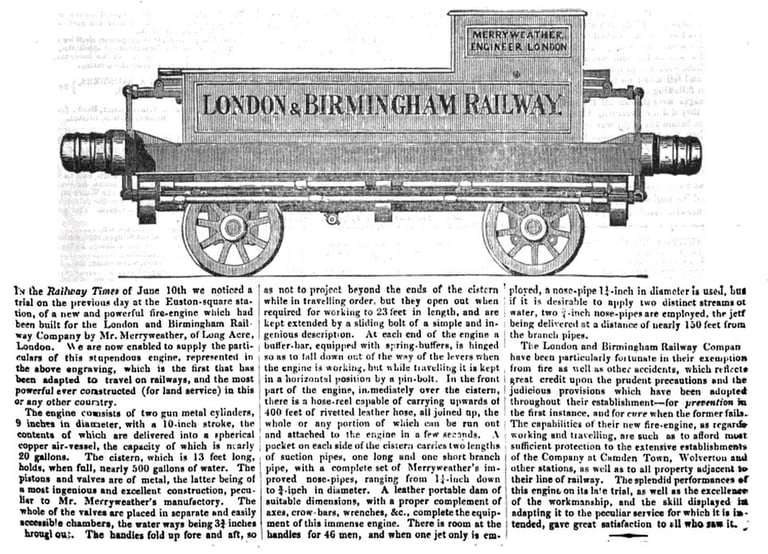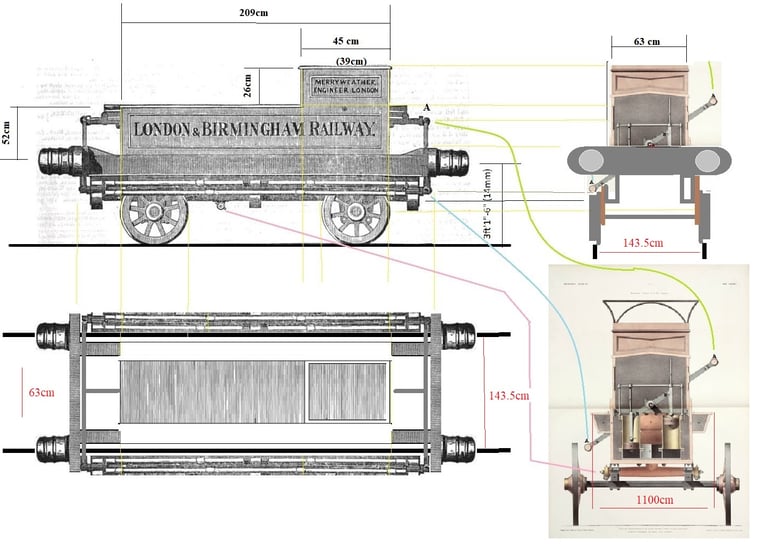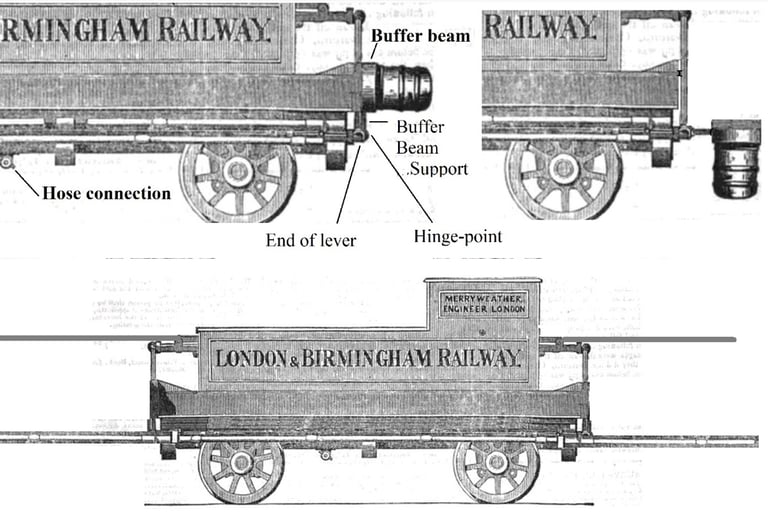On June the 10th, 1842 to much aplomb the press announced that the ‘railway property from Euston to Camden and along the length of the line would be protected by a fire tender that could be quickly brought to the location of any fire on company property by virtue of being mounted on a railway wagon and thus able to be pulled by an engine at some speed.’
The Berkshire Chronicle tells us ‘a first class [fire] engine to run on the London & Birmingham Railway was put on the line a few days back at the Camden Town station by Mr Merryweather, the engineer, when it was attached to one of the locomotives and propelled to Euston-square station… The engine is mounted on railway wheels, and fitted with buffers, similar to the carriages… The engine being well manned by 40 of the railway men… a hose was put to each side, when two distinct bodies of water were delivered, showing that if two buildings near each other were on fire the engine can be brought to bear upon them both at one and the same time.’
Back in 1837 The London & Birmingham had decided that they would not insure their buildings against fire. Mr Bruyeres, 20th May, brought to the director’s attention that “in the event of a fire there is no engine on the premises” and he wondered whether “it would not be expedient to have one at both Euston and Birmingham mounted on rail wheels as being more efficient for these stations in case of accident.” The subsequent report, a week later, concluded that: Birmingham did not need an engine due to the number of ‘plug’ points for water around the station but that hose should be ordered.
“At the Euston station – there is a considerable command of water – but having different opinions as to the capability of its reaching the tops of buildings without the assistance of an engine, I have instructed Mr Smith to try with the pipes and report the result to me for the information of the committee. I have also written to Mr Bury to enquire if he thinks it advisable that there be an engine at stationed at Wolverton.” Minute 242 concludes “That the superintendent be authorised to procurea fire engine for the Camden station with apparatus to complete as estiamted at £95’4’0 – also the necessary length of hose for the Birmingham Station.”
Although the Metropolitan Archive did have reference to a purchase of the Merryweather Fire engines for Swindon by Daniel Gooch, I couldn’t find reference to the London & Birmingham engine.
The London & Birmingham Railway & the Merryweather Co. : The first rail mounted Fire tender?




Deciphering the side elevation
When I was first shown the illustration from the Illustrated London News, I had some difficulty seeing how it converted from a wagon to a fire engine and how the fire engine itself worked. The following images are edited from the original above. However as I read about Merryweathers, and many other similar manual hand pump engines, it became clear what certain details in the London & Birmingham vehicle illustration corresponded to the horse drawn version of the Merryweather fire engine.
Another aspect that was confusing were the pump handles but again comparing to the road version however this became clear. The handles are wooden poles braced to metal levers but the wooden poles are hinged so that they can fold. It is possible to see how the suggested crew of forty men might just fit along the length of the handles when they are unfolded in this way. The image above has had the buffers removed to simplify the drawing.
3D and Technical knowledge
I obtained dimensions from one of the two existing similar Merryweather manual pump engines through the kindness of the Whistable Museum. David used these dimensions as a startpoint. Two areas were particularly difficult, the cross bracing and the drawbar, the latter which is entirely absent in the drawing. David did an incredible job in realising the shape in 3D.
We finally settled on the arrangement shown in the illustration below. David concluded that the drawbar must have run through the entire length of the chassis but there remains the missing detail of how this fitted through the buffer beam or how this particular detail worked
The chassis of course is very different and according to the hyperbole this was a much more powerful engine that the standard model.
History: Merryweather and the L&B fire tender
In 1841 the Merryweather Co. had delivered to the London & Birmingham railway a manual pump fire engine. This was described as differing from their standard model, with some increased capacities, but visually it resembled their standard model as shown by design similarities with existing museum pieces.
Merryweather at this time was based at Long Acre. In 1791 Henry Lott joined the firm and later took over full control of the company and when he retired handed it over to his nephew by marriage, Moses Merryweather (1791-1872). He and his sons, including Richard Moses Merryweather (1839-1877) managed the business and it was known as Merryweather and Sons.
In the 1830s customers included parishes and vestries in London and beyond including Ireland, fire insurance companies including Sun Fire Office and the Hand in Hand, for other businesses and for individuals mainly the aristocracy.
Merryweather evidently thought that the railway market was one to develop! Interestingly there is evidence that it did, see below, but not quite as he expected. His sending of letters to newspapers, of which this is an example, shows a good sense of marketing capability and an astuteness to gain free publicity!
Endorsement
Much of the Merryweather history has references to good connections to aristocracy and the well to do. Many journalists and writers, as well as Merryweather’s own self publicity, talk of the machinery’s beauty, elegance, technological superiority and incredible capacity. While we can lay these boasts aside there is a definite role of in Merryweathers’ connections to their business success.
One such connection are the Dukes of Buckingham. They had various involvements in railways and it is claimed that the 3rd Duke had such an interest in Merryweather’s and extinguishing fires that he was present as a volunteer and taking much interest in the ‘work of the firm’. This Duke the 3rd Duke of Buckingham and Chandos was to become the Chairman of the LNWR between 1853 and 1861 perhaps he had some influence in attracting the London & Birmingham directors attention to Merryweathers product?
1846
The fire tender was still at work on the LNWR 1846, as the Sun Newspapers, amongst others reports that a fire in the Chalk farm stores caused much alarm. An amount of ‘cotton wipings’ having caught alight following an explosion of some fog signals. The fire tender arrived quickly and ‘judiciously’ distributed water extinguishing the flames. The building however was much damaged, particularly the floor which was ‘much burned’, and the contents which were damaged by both the fire, and as happens, the water.
Other Fire engines in 1843 and later
Around this time the Great Western Railway ordered fire engines for Swindon and the GJR ordered one for Crewe. The later gained fame being stabled adjacent to the Webb Coupe under the Chester Bridge. This location was used later with a fire train but I haven’t been able to find details of the original GJR purchase.
Three forms of railway fire service emerged in later years regarding; there are several examples of horse drawn fire engines being mounted on railway flat wagons, such as at Derby on the Midland railway, Tyne Yard on the NER and at Horwich on the Lancashire and Yorkshire Railway. All the examples I have found had Merryweather steamer horsedrawn pump engines that were stabled on railway flats but could also be demounted and brought to fires beyond the range of the tracks. This form overcame the restriction that limits the range of rail mounted fire appliances.
Another form was the establishment of (road vehicle) fire stations under the administration of the railway company and finally the creation of fire fighting trains. David Bond is researching the Wolverton fire train which included a fire engine mounted on a locomotive tender chassis which as with that at Crew and Horwich were very different beasts.
Acknowledgements
Peter Banbury & Gail Rogers of the Whitstable Museum for their kind support and taking the time to provide dimensions of their 1842 Merryweather engines. Melissa Barnett also for providing information on the Parish of Chippenham 1842 Merryweather. Richard Hickman of the FBS (Fire Brigade Society). Jeff Wright, of Merryweather and Sons, for putting me in touch with Neil Bennett to whom I am extremely grateful for the extra references.
References:
Archives:
National Archives, Minutes of the Coaching & Policing Committee (Carriage Sub Committee) RAIL 384/94 and 95 – Dec 1839 – Feb 1842. London Metropolitan Archives, Title: Day book - Reference Code: LMA/4516/01/001 - Dates of Creation: 1830 Dec - 1844 Feb
Scope: Contains daily accounts giving the date, customer's name, details of the order and cost (1830 Dec - 1835 Jul). At back of volume: draft out-going letters to customers (1842 Aug - 1844 Feb)
Newspapers
Railway Times – Vol 4 P.1168, 1841 – ‘Order placed with Merryweather’
Bucks Herald - Saturday 30th October 1841 - :Letter to the Editor, R. MERRY WEATHER
Railway Times - 11th June 1842 – ‘Euston Sq Demonstration’
Morning Post – 11th June 1842, P.7
Berkshire Chronicle – 25th Jun 1842 p 4
Mechanics Magazine – 9th July 1842 p.17-18
Globe - Monday 12 January 1846 – ‘Chalk Farm stores fire’
The Sun – Tuesday 13th January 1846 - ‘Chalk Farm stores fire’
Books
The House of Merryweather: A Record of Two Centuries, Merryweather & Sons Ltd (attributed to James Compton Merryweather), published by Merritt & Hatcher Ltd, 1901
Merryweather & Sons Ltd. Horton Ralph. Publisher: Fire Brigade Society: 2013 . Edition: 1st. ISBN Number: 1871335175. ISBN-13: 9781871335170
Links
https://corinthian.online/stowes-rich-history/
https://www.cheshirefire.gov.uk/about-us/local-fire-stations/crewe-fire-station/history




